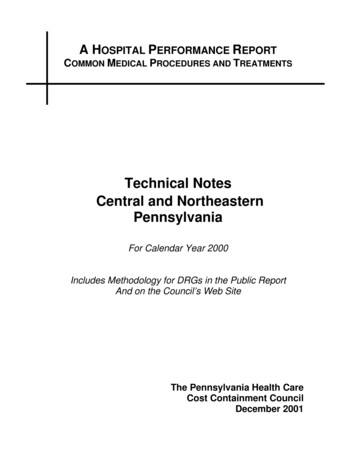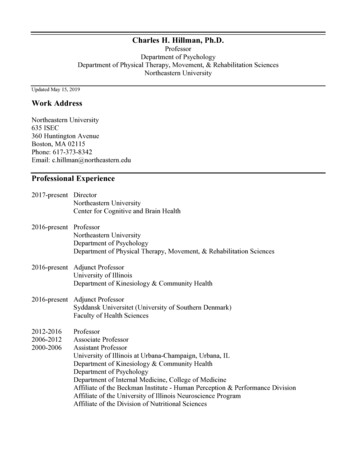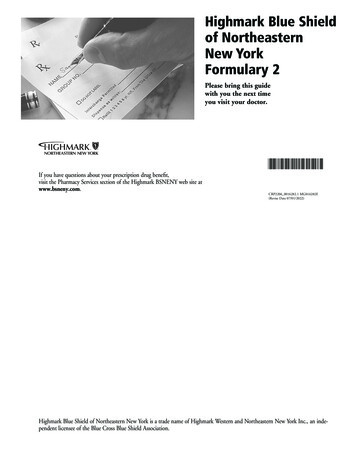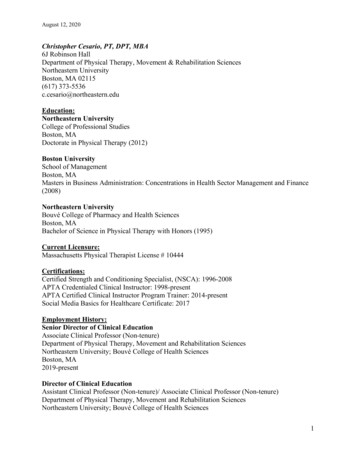
Transcription
A HOSPITAL PERFORMANCE REPORTCOMMON MEDICAL PROCEDURES AND TREATMENTSTechnical NotesCentral and NortheasternPennsylvaniaFor Calendar Year 2000Includes Methodology for DRGs in the Public ReportAnd on the Council’s Web SiteThe Pennsylvania Health CareCost Containment CouncilDecember 2001
ForewordThe 2000 Hospital Performance Report utilizes all the improvements developed and implementedin the 1997, 1998 and 1999 versions of the Hospital Performance Report. These outcomes ofcare analyses responded to information requests by purchasers, providers, insurers andindividual consumers for a diversity of medical and surgical treatments. The improvements forthe past several reporting years included methodological changes and streamlined content andpresentation for ease of understanding.New to the 2000 report is the inclusion of the “Heart Attack with PTCA/Stent” DRG. The Webversion of the 2000 Hospital Performance Report has also been expanded to include a riskadjusted readmission rate analysis for all appropriate DRGs. In addition, a new DRG, MedicalBack Problems, has been added to the Web-site DRG listing.The 2000 Hospital Performance Report continues to be a “flagship” report in which thePennsylvania Health Care Cost Containment Council is able to disperse a wide range ofinformation on various clinical conditions and outcomes.Individuals seeking further detail should reference the Council’s Web site.Pennsylvania Health Care Cost Containment Council225 Market Street, Suite 400Harrisburg, PA 17101Phone: (717) 232-6787Fax: (717) 232-3821www.phc4.orgMarc P. Volavka, Executive Directori
TECHNICAL ADVISORY GROUPTO THE PENNSYLVANIA HEALTH CARE COST CONTAINMENT COUNCILThe Council has made decisions in conjunction with its Technical Advisory Group (astanding committee charged with overseeing all technical and methodological aspects ofthe Council’s Research). The Council appreciates the dedicated assistance it receivedin creating this report.List of MembersDavid B. Nash, MD, MBA, Chair, Associate Dean and Director, Office of Health Policy &Clinical Outcomes, Thomas Jefferson University Hospital, Philadelphia, PA(appointed April 1992)J. Marvin Bentley, PhD, Associate Professor of Health Economics, School of PublicAffairs, Penn State University Harrisburg, Middletown, PA (appointed February1995)David B. Campbell, MD, Professor and Chief, Cardiothoracic Surgery, Milton S.Hershey Medical Center, Hershey, PA (appointed April 1995)Paul N. Casale, MD, FACC, The Heart Group, Lancaster, PA (appointed January 1995)Donald E. Fetterolf, MD, MBA, Vice President/Senior Medical Officer, HealthcareInformation and Research, Highmark, Inc., Pittsburgh, PA (appointed April 1992)James R. Grana, PhD, Director of Research, U.S. Quality Algorithms, Inc./Aetna U.S.Healthcare, Blue Bell, PA (appointed February 1998)George R. Green, MD, Physician-In-Chief, Division of Allergy and Immunology,Department of Medicine, Abington Memorial Hospital, Abington, PA (appointedNovember 1993)Sheryl F. Kelsey, PhD, Professor of Epidemiology, University of Pittsburgh, GraduateSchool of Public Health, Pittsburgh, PA (appointed November 1993)Judith R. Lave, PhD, Professor of Health Economics, Graduate School of Public Health,University of Pittsburgh, Pittsburgh, PA (appointed April 1995)ii
TABLE OF CONTENTSForeword.iTechnical Advisory Group List of Members. iiOverview.1What is new for the 2000 Hospital Performance Report .2DRG Inclusion.4Data Collection and Verification .7Study Population.7A. Inclusion Criteria.7B. Hospital Exclusions .8Methodology .9A. In-Hospital Mortality Analysis .9B. Length of Stay Analysis .11C. Charge Analysis .11D. Readmission Analysis .12E. Reported Measures Specific to Heart Attack – Medical Management.13LIST OF TABLES1. Rank of DRGs by Volume, Mortality, and Variability among Hospitals with Respect toMortality Rate .142. Statewide Exclusions from Hospital Performance Analysis.183. Regional Charge Upper Trim Point by DRGA. Central and Northeastern Pennsylvania: Region 7 .21B. Central and Northeastern Pennsylvania: Region 8 .22C. Central and Northeastern Pennsylvania: Region 9 .234. Regional Average LOS Before and After Trimming by DRG .245. Exclusions from Mortality Analysis by DRG.256. Exclusions from Length of Stay Analysis by DRG .267. Exclusions from Charge Analysis by DRG.278. Exclusions from Readmissions Analysis by DRG.289. Summary of the Hospitals Totally Excluded From the HPR and Web Site Release .29APPENDIXGlossary of Abbreviated Terms .30DRGs Excluded from Readmission Rate .30
2000 HPR Technical NotesPage 1Technical Notes2000 Hospital Performance ReportThis document serves as a technical supplement to the 2000 Hospital Performance Report.Technical notes describe the methodology of the analyses and outline development of thereport format and presentation. Detailed information relating to methodology is not duplicatedherein but is referenced where appropriate. Copies of earlier technical reports can beobtained from PHC4 or from the PHC4 website (www.phc4.org).Overview of the 2000 Hospital Performance ReportThe printed report presents measures for 22 selected Diagnosis Related Groups (DRGs): risk-adjusted in-hospital mortalityrisk-adjusted average length of stayregionally adjusted average hospital chargerisk-adjusted readmission rateIt should be noted that not all outcome measures are reported for all DRGs. In-hospitalmortality is identified in the patient discharge record as a discharge status of “20.” Length ofstay is calculated by subtracting the admit date from the discharge date. Hospital charge isthe patient total charge excluding professional fees. A hospital readmission is defined as anacute care rehospitalization, for any reason, which occurs within 30 days of the dischargedate of the original hospitalization.New to the 2000 report is the inclusion of the “Heart Attack with PTCA/Stent” DRG. Theaddition of these heart attack cases (which are treated with interventional techniques)complements the already-reported Heart Attack – Medical Management cases (which are, bydefinition, treated medically). This addition will allow for a broader analysis of heart attackcases across Pennsylvania hospitals. The outcomes reported for this “DRG” include a riskadjusted mortality rating, risk-adjusted average length of stay, and average charge.This new clinical group is a composite of cases in DRGs 112 and 116 that had a principaldiagnosis of AMI (ICD.9.CM code 410.x1, x 0-9) and PTCA/stent procedure performed(ICD.9.CM codes 36.01, 36.02, 36.05, 36.06). Unlike the other DRGs (which include casesthat are treated at the majority of Pennsylvania hospitals), Heart Attack with PTCA/Stent iscomprised of cases that are treated only at hospitals that provide advanced cardiac careservices in Pennsylvania. For this reason, only facilities that provide these services arereported for this DRG.In addition, 51 DRGs (1 new DRG: 243 – Medical Back Problems) are included on theCouncil’s Web site. A total of 73 DRGs (22 public document and 51 Web site only) arepublished for 2000. Outcomes for the 22 public document DRGs will be published in thetraditional “paper format,” as well as in an “electronic format,” on the Council’s Web site.Outcomes for DRGs that are referred to as Web site only are not published in the traditional“paper format,” but can be viewed on the Council’s Web site.Summaries by DRG are provided by state, region, and individual hospitals for each of thethree “wide-area” regional reports. The three “wide-area” regions allow a broader range ofcomparison among acute care facilities: These wide-area regions are defined as: Western Pennsylvania (comprised of Southwestern Pennsylvania—Region 1,Northwest Pennsylvania—Region 2, and Southern Allegheny—Region 3) Central and Northeastern (comprised of Northcentral Pennsylvania—Region 4,Southcentral Pennsylvania—Region 5, and Northeastern Pennsylvania—Region 6) Southeastern Pennsylvania (comprised of Lehigh Valley/Reading—Region 7,Suburban Philadelphia—Region 8, and the City of Philadelphia—Region 9)
2000 HPR Technical NotesPage 2What is new for the 2000 Hospital Performance Report?The following table summarizes methodologies developed for the 1999 Report and enhancementsdeveloped for the 2000 Report.1999 MethodologyMeasures Reported2000 MethodologyIn-hospital mortalityAverage hospital chargeAverage length of stay1Readmission rateTransfer-out to acute care % (HeartAttack – Medical Management DRGonly)Notation of status as provider ofadvanced cardiac care (HeartAttack – Medical Management DRGonly)Same with the following modifications:Readmission rates now reported for allappropriate Web DRGs. Readmissionrates not reported for lung cancer, heartattack – medical management, heartattack with PTCA/stent, or DRGs (publicand web) that:Are pediatricHave “Misc.” or “Other” innameContain a high volume ( 10%)of cancer-related casesHospitalsAcute care facilities (excluding children’shospitals for adult DRGs)SameDefinition of ComplianceAcute care facilities that submitted datacontaining less than 15% missingseverity scores for all DRGs in whichseverity score is requiredSameDRGs: Public Document21 included22 in totalDRGs: Web site71 in total (21 public document and 50additional)73 in total (22 public document and 51additional)Comparative DatabasePennsylvania Hospital 1999 InpatientDatabase with all relevant dataexcluding pediatric cases for adultcomparative analyses and excludingadult cases for pediatric comparativeanalysesPennsylvania Hospital 2000 InpatientDatabase with all relevant dataexcluding pediatric cases for adultcomparative analyses and excludingadult cases for pediatric comparativeanalysesRisk AdjustmentTechniqueIndirect standardizationSameAdjustment Factors(for in-hospital mortality,length of stay, andreadmission)Atlas Outcomes Severity of IllnessStatistical Tests(for in-hospital mortality)Exact Binomial TestSameTrim Methodology(for charges and length ofstay) /- 3.0 Interquartile RangeOutlier exclusion is consideredseparately.Same2Age categories : (DRG dependent):Ages 18 – 64, 65 – 79, 80 , orAges 18 – 39, 40 – 69, 70 , orAges 0 – 5, 6 – 12,13 – 17Cancer categories:None3Malignant neoplasm & in situ4History of cancer5Patient gender (only used for 2pediatric DRGs)Atlas Outcomes Severity of Illness(same)Age categories (same)Cancer categories (same)Patient gender (only used for 2pediatric DRGs - same)1Readmission was not analyzed for heart attack-medical management, lung cancer, or Web site only DRGs.2Age adjustment is dependent on the distribution of age in the cases captured by a particular DRG3No cancer diagnosis codes present4ICD.9.CM diagnosis codes 140.0 – 208.9 inclusive or 230.0– 234.9 inclusive5ICD.9.CM diagnosis codes V10.00 – V10.90 inclusive
2000 HPR Technical NotesPage 3What is the difference between the 22 DRGs reported in the public document andthe 51 DRGs released on the Council’s Web site only?The following table summarizes the differences between what is reported in the public reportdocument (the traditional “paper format”) and what is reported for the 51 Web site only DRGs.Note that descriptive and outcome information regarding the 22 DRGs chosen for the publicdocument are displayed on the Council’s Web site; any information that is published for the 22DRGs in the public document will also be displayed on the Web site.DRGs: Public DocumentMeasures ReportedIn-hospital mortalityAverage hospital chargeAverage length of stayReadmission rate (for appropriateDRGs)Transfer to acute care % (HeartAttack – Medical Management only)Notation of status as provider ofadvanced cardiac care (HeartAttack – Medical Management only)DRGs: Web site OnlySameHospitalsAll acute care facilities (excludingchildren’s hospitals)Acute care facilities with 5 or morecases in a DRGDRGs22 included51 included (48 adult and 5 pediatric—2DRGs will be split into separate adultand pediatric analyses)Comparative DatabasePennsylvania Hospital 2000 InpatientDatabase with all relevant data(pediatric cases have been removed)48 Adult DRGs1: same25 Pediatric DRGs : PennsylvaniaHospital 2000 Inpatient Database withall relevant pediatric data1Includes 46 adult only and 2 pediatric/adult DRGs2Includes 3 pediatric only and 2 pediatric/adult DRGs
2000 HPR Technical NotesPage 4The 22 DRGs included in the 2000 public document and Web site release are:DRG01Medical7879Pulmonary EmbolismRespiratory Infections and Inflammations,‡Age Greater Than 17 with CCRespiratory NeoplasmsChronic Obstructive Pulmonary DiseaseBlood Clot in LungLung Infections,complicatedLung CancerChronic ObstructivePulmonary Disease(COPD)Pneumonia, gical138148154Simple Pneumonia with Pleurisy, Age‡Greater Than 17 with CCPTCA/Stent for Acute Myocardial InfarctionMedical Treatment - Acute MyocardialInfarctionHeart Failure and ShockPeripheral Vascular Disorders with CC‡Cardiac Arrhythmia and Conduction‡Disorders with CCMajor Small and Large Bowel Procedures‡with CCStomach, Esophageal and Duodenal‡Procedures, Age Greater Than 17 with CC174GI Hemorrhage with CC‡188Other Digestive System Diagnoses, Age‡Greater Than 17 with CCHip and Femur Procedures Except MajorJoint Procedures, Age Greater Than 17 with‡CCDiabetes, Age Greater Than 35Renal FailureKidney and Urinary Tract Infections, Age‡Greater Than 17 with CCSepticemia, Age Greater Than 17Poisoning and Toxic Effects of Drugs, Age‡Greater Than 17 with CC‡Other Vascular Procedures with CC2102943163204164494783Medical/SurgicalStroke (Brain Attack)112,1161,31212,31231271302MDCSpecific Cerebrovascular Disorders ExceptTransient Ischemic Attack891Common Names148288‡DescriptionHeart Attack withPTCA/stentHeart Attack - MedicalManagementHeart Failure & ShockVascular Disorders exceptheart, complicatedAbnormal Heartbeat,complicatedMajor IntestinalProcedures, complicatedStomach & SmallIntestinal Operations,complicatedStomach & IntestinalBleeding, complicatedStomach & IntestinalComplications & DisordersHip Operations exceptreplacement, complicatedDiabetesKidney FailureKidney & UrinaryInfections, complicatedSepticemiaPoisoning & Toxic Effectsof Drugs, complicatedVascular Operationsexcept heart, complicatedCC – complication or comorbid conditionIncludes only those cases that had a principal diagnosis of AMI and had a PTCA with or without stent procedure performed.Because medically treated heart attack patients who die are given a separate DRG (123), DRGs for all medicallymanaged heart attack patients were combined for the mortality analysis.Hospital charges for this combined group of DRGs (i.e., 121, 122 and 123 were combined; appropriate cases in 112and 116 were combined) were case-mix adjusted to provide equitable comparisons. Not all AMI cases are captured inthese DRGs. AMI patients transferred to another acute care facility have been excluded from analysis for thendtransferring hospital. The transferred cases are analyzed at the 2 (receiving) hospital. If a PTCA/stent was performedfor the AMI patient, the cases are captured in DRGs 112, 116. AMI patients treated with other therapeutic interventions(e.g., CABG) are not captured. Approximately 25 percent of acute care hospitals have the capability to provide thetherapeutic intervention of PTCA/stent.
2000 HPR Technical NotesPage 5The 51 DRGs released on the Council’s Web site only are:(Note: Pediatric cases for DRGs 410 and 167 are reported separately.)DRG15Craniotomy, Age Greater than 17 Except forTraumaExtracranial Vascular Procedures12Degenerative Nervous System Disorders15Transient Ischemic Attack and PrecerebralOcclusionsSeizure and Headache, Age Greater than 17 with‡CCSeizure and Headache, Age Greater than 17‡without CC‡Other Disorders of Nervous System with CC2425347576879091969798113120125131139Major Chest ProceduresOther Respiratory System OR Procedures with‡CCPulmonary Edema and Respiratory FailureSimple Pneumonia and Pleurisy, Age Greater than‡17 without CCSimple Pneumonia and Pleurisy, Age 0 - 17Bronchitis and Asthma, Age Greater than 17 with‡CCBronchitis and Asthma, Age Greater than 17‡without CCBronchitis and Asthma, Age 0 - 17Amputation for Circulatory System DisordersExcept Upper Limb and ToeOther Circulatory System OR ProceduresCirculatory Disorders Except Acute MyocardialInfarction with Cardiac Catheterization withoutComplex Diagnosis‡Peripheral Vascular Disorders without CC141Cardiac Arrhythmia and Conduction Disorders‡without CC‡Syncope and Collapse with CC143144Chest Pain‡Other Circulatory System Diagnoses with CC167172Appendectomy without Complicated Principal‡Diagnosis without CCAppendectomy without Complicated Principal‡Diagnosis without CC‡Digestive Malignancy with CC180GI Obstruction with CC167‡Description‡CC – complication or comorbid conditionMDCMedical/SurgicalBrain Surgery except for trauma01SurgicalRemoval of Head, Neck VesselBlockageDegenerative NeurologicDisordersTransient Ischemic Attack &Blocked Vessel of Head, NeckSeizure & Headache,complicatedSeizure & Headache,uncomplicatedNeurologic Symptoms &Disorders, complicatedMajor Lung OperationsMiscellaneous Lung Procedures,complicatedFluid in Lung & Breathing FailurePneumonia, icalCommon NamesPediatric PneumoniaBronchitis & Asthma,complicatedBronchitis & Asthma,uncomplicatedPediatric Bronchitis & AsthmaNon-Traumatic Lower LimbAmputation except toeMiscellaneous CirculatoryOperationsHeart Catheterization withoutheart attack, uncomplicatedVascular Disorders except heart,uncomplicatedAbnormal Heartbeat,uncomplicatedHypotension & Fainting,complicatedChest PainExtensive CardiovascularComplications & DisordersRemoval of Appendix,uncomplicatedPediatric Removal of Appendix,uncomplicatedStomach & Intestinal Cancer,complicatedStomach & IntestinalObstruction, complicated
2000 HPR Technical NotesPage 6The 51 DRGs released on the Council’s Web site only are: (continued)(Note: Pediatric cases for DRGs 410 and 167 are reported separately.)DRGDescriptionCommon NamesMDCMedical/Surgical182Stomach & Intestinal Infections &Disorders, complicatedStomach & Intestinal Infections &Disorders, edical204Disorders of Pancreas Except Malignancy07Medical205Disorders of Liver Except Malignancy, Cirrhosis‡and Alcoholic Hepatitis with calMedical10Medical310Wound Debridement and Skin Graft Except Handfor Musculoskeletal and Connective TissueDisordersPathological Fractures and Musculoskeletal andConnective Tissue MalignancyMedical Back Problems‡Cellulitis, Age Greater than 17 with CCNutritional and Miscellaneous Metabolic Disorders,‡Age Greater than 17 with CCNutritional and Miscellaneous Metabolic Disorders,‡Age Greater than 17 without CC‡Transurethral Procedures with CCPediatric Stomach & IntestinalInfections & DisordersCirrhosis & Alcoholic HepatitisLiver, Gallbladder or PancreaticCancerNoncancerous PancreaticDisordersLiver Disease except cancer,cirrhosis, alcoholic hepatitis,complicatedWound Debridement & SkinGrafts except hand06202203Esophagitis, Gastroenteritis and Miscellaneous‡Digestive Disorders, Age Greater than 17 with CCEsophagitis, Gastroenteritis and MiscellaneousDigestive Disorders, Age Greater than 17 without‡CCEsophagitis, Gastroenteritis and MiscellaneousDigestive Disorders, Age 0 - 17Cirrhosis and Alcoholic HepatitisMalignancy of Hepatobiliary System or Pancreas11Surgical315323Other Kidney and Urinary Tract OR Procedures‡Urinary Stones with CC and/or ESW Lithotripsy1111SurgicalMedical331Other Kidney and Urinary Tract Diagnoses, Age‡Greater than 17 with CCRed Blood Cell Disorders, Age Greater than 17Reticuloendothelial and Immunity Disorders with‡CC‡Lymphoma and Nonacute Leukemia with otherapy without Acute Leukemia asSecondary DiagnosisChemotherapy without Acute Leukemia asSecondary DiagnosisOR Procedure for Infectious and ParasiticDiseasesPostoperative and Posttraumatic InfectionsLaparoscopic Cholecystectomy without Common‡Duct Exploration with CCLaparoscopic Cholecystectomy without Common‡Duct Exploration without CCCC – complication or comorbid conditionBone Cancer & Non-TraumaticFracturesMedical Back ProblemsCellulitis, complicatedNutritional & MetabolicDeficiencies, complicatedNutritional & MetabolicDeficiencies, uncomplicatedTransurethral Procedures exceptprostatectomy, complicatedVascular Surgery for DialysisUrinary Stones includinglithotripsy, complicatedKidney & Urinary Disordersexcept Infection, complicatedAnemia & Transfusion ReactionLymphatic & Immune Disorders,complicatedLymphoma & Non-AcuteLeukemia, complicatedChemotherapy except for acuteleukemiaPediatric Chemotherapy exceptfor acute leukemiaSurgery for Infectious or ParasiticDiseaseInfection after Surgery or TraumaLaparoscopic GallbladderRemoval, complicatedLaparoscopic GallbladderRemoval, uncomplicated
2000 HPR Technical NotesPage 7DATA COLLECTION AND VERIFICATIONThe Pennsylvania Health Care Cost Containment Council is mandated by state law to collectand disseminate health care data using guidelines set forth by the Health Care FinancingAdministration. These data, obtained from the UB-92 (Uniform Billing Form), are submittedquarterly to the Council by Pennsylvania hospitals via magnetic media as directed underSection 912, Data Submission Requirements, of Act 89. The data include demographicinformation, hospital charges, and diagnosis and procedure codes using ICD.9.CM(International Classification of Diseases, Ninth Revision, Clinical Modification).In a contractual agreement with Cardinal Health Information Companies-MediQual inMarlborough, Massachusetts, hospitals are required to use CHIC-MediQual’s AtlasOutcomes Severity of Illness System to abstract patient severity information. TheAdmission Severity Group (ASG) scores generated by this system are submitted to theCouncil for a select group of acute care inpatient records covering approximately 75 percentof acute care hospital discharges.The data used for this report was submitted to the Pennsylvania Health Care CostContainment Council by Pennsylvania general acute care (GAC) and specialty acute carehospitals covering the period of calendar year 2000. Federal hospitals were not required tosubmit data.Facilities are required to submit data to the Council on a quarterly basis by 90 days from thelast day of each quarter. Upon receipt of the data, media verification is performed to assuredata have been submitted in a readable format. The data verification process continues withextensive quality assurance checks and matching of admission severity scores to inpatientrecords. Error reports are generated and returned to each facility with an opportunity tocorrect any problems.STUDY POPULATIONInclusion CriteriaThe study population for the 2000 Hospital Performance Report public document (i.e., theprinted report) includes useable records from all Pennsylvania GAC and specialty acute carehospital discharges in 2000 for adults only (that is, pediatric cases (age 18) are excludedfrom the study). Note that the incidence of pediatric cases for these particular DRGsrepresents a very small percentage of all the cases for these DRGs ( 0.3%) in the publicdocument. Adult cases that are included are categorized into one of the twenty-two DRGsincluded in the public document. Because of the importance of discharge status, especiallyin the mortality analysis, only records with a valid discharge status are retained. Only recordswith the following types of discharge status were included: Discharged to home or self care (routine discharge)Discharged/transferred to another short term general hospital for inpatient careDischarged/transferred to skilled nursing facility (SNF)Discharged/transferred to an intermediate care facility (ICF)Discharged/transferred to another type of institution for inpatient care or referred for outpatient services toanother institutionDischarged/transferred to home under care of organized home health service organizationLeft against medical advice or discontinued careDischarged/transferred to home under care of a Home IV providerExpiredIt should be noted, however, that a small number of records (less than 0.1 percent) areremoved from the analyses if they do not meet the above criteria.
2000 HPR Technical NotesPage 8The study population for the additional DRGs that are reported on the Council Web site isdichotomized by age; that is, adult cases only are analyzed for 48 of the DRGs, and pediatriccases only are analyzed for 5 of the DRGs. [Adult and pediatric cases for Removal ofAppendix, Uncomplicated (DRG 167) and Chemotherapy without Acute Leukemia asSecondary Diagnosis (DRG 410) are reported separately.] Categorization of cases intoDRGs and the importance of discharge status for record retention in the comparativedatabase are the same as noted for the public document.Since all cases have to be categorized by age in order to be classified as pediatric or adult,those cases with invalid age are removed prior to beginning any analysis. The proportion ofrecords with invalid age is very small when compared to all the records that are submitted forcalendar year 2000 by acute care facilities (39 invalid age records out of more than 1.79million records submitted are invalid for age).Hospital ExclusionsIn 2000 there were 187 general acute care facilities and seven specialty acute care facilitiesin Pennsylvania, for a total population of 194 facilities.The number of cases included in any single type of analysis in the 2000 report variesbecause of unreported data or incomplete data submitted by the 194 acute care facilities ordiffering exclusion criteria. Table 9 on page 29 lists the hospitals that were excluded in the2000 public document report and Web release, for reasons related to non-compliance orclosures. Although data and analyses specific to these facilities are not included in thepublic document or Web release editions of the Hospital Performance Report, theirvalid records have been retained in the statistical analyses for in-hospital mortality,length of stay, charges, and readmission. Valid records for these hospitals are capturedin the Technical Report tables.Additional Hospital ExclusionsFour children’s hospitals were excluded from any display of adult outcomes (both publicdocument and Web site). Because the majority of their patients were under the age of 18,comparisons between these special acute care hospitals and general acute care hospitalswere not parallel.Partial ExclusionsIn the public document, analyses for the 22 reported DRGs are appropriately suppressed atthe DRG level for those facilities that have an insufficient patient count (between 1 and 4cases, inclusive, in the mortality analysis) to be included in the analysis for practical reasons.There are 181 DRG/hospital combinations in this group of exclusions. Due to small samplesize, no further analysis is displayed on those data. Information found on the Council’s Website pertaining to these 22 DRGs i
David B. Nash, MD, MBA, Chair, Associate Dean and Director, Office of Health Policy & Clinical Outcomes, Thomas Jefferson University Hospital, Philadelphia, PA (appointed April 1992) J. Marvin Bentley, PhD, Associate Professor of Health Economics, School of Public Affairs, Penn State University Harrisburg, Middletown, PA (appointed February 1995)











